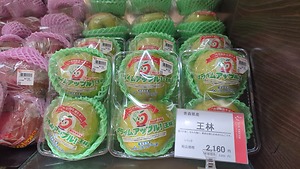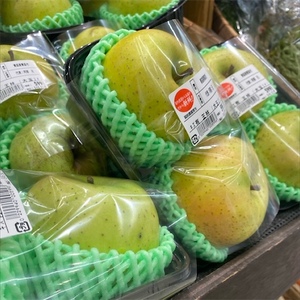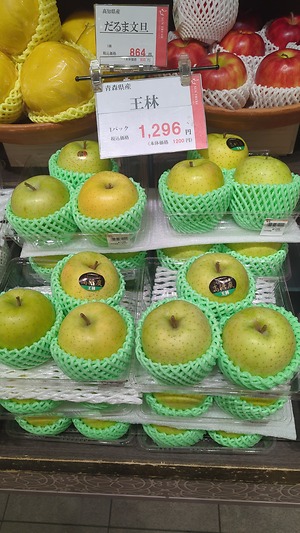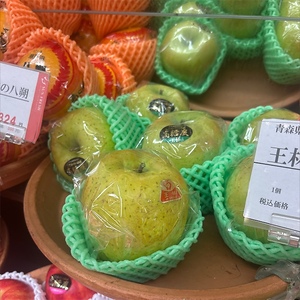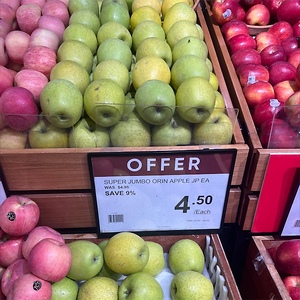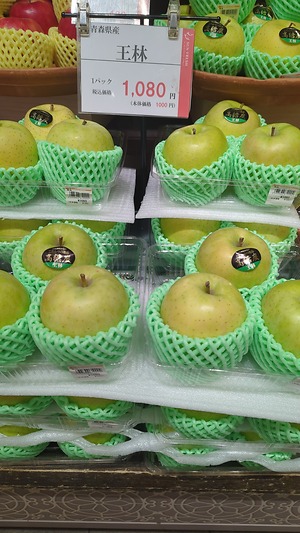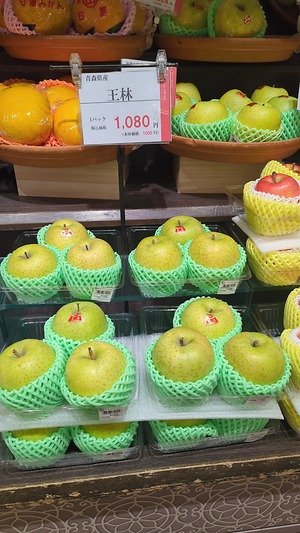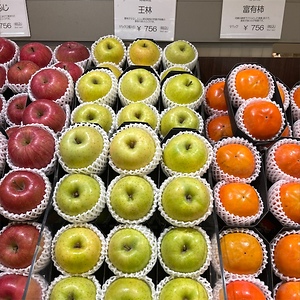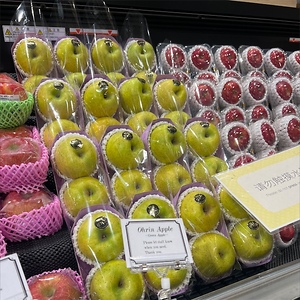

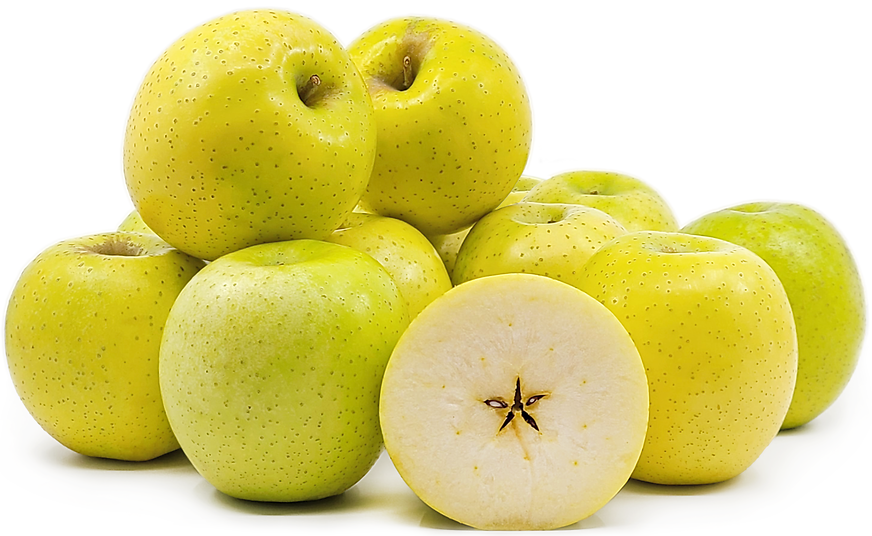
Ourin Apples
Estimated Inventory, lb : 0
Description/Taste
Ourin apples are a medium to large varietal, averaging 7 to 10 centimeters in diameter, and have a conical to slightly slanted appearance with flattened shoulders tapering to a narrow, level base. The apple’s skin is semi-thin, taut, and chewy, found in yellow-green hues, ripening into shades of yellow. The skin is also covered in raised, brown-grey russet lenticels, giving the surface a rough, textured, and bumpy feel. Depending on exposure to sunlight during cultivation, the skin may bear a light pink to orange-red blush. Underneath the surface, the flesh is pale yellow and aqueous with a medium grain, encasing a small central core filled with tiny black-brown seeds. The flesh also provides a soft, delicate, and light texture mixed with a subtle crispness, releasing a honeyed, almost tropical fragrance. Ourin apples contain high sugar, ranging from 15 to 19 Brix, and low acidity, creating a sweet, subacid, and perfumed flavor with nuances of pears and pineapples.
Seasons/Availability
Ourin apples are available in the late fall through early spring.
Current Facts
Ourin apples, botanically classified as Malus domestica, are a Japanese variety belonging to the Rosaceae family. This late-season cultivar was created from multiple generations of natural breeding, with the most recognized cross being between the indo, another Japanese apple, and the golden delicious. Ourin apples are the most produced green apple variety in Japan and are marketed using several name variations, including Orin, Ohrin, and Sweet Ourin apples. While the apples are somewhat common in markets throughout Japan, ranked and sold according to their size, appearance, and cultivation techniques, Ourin apples are favored for their sweet taste, light coloring, and soft flesh, typically consumed as a dessert apple.
Nutritional Value
Ourin apples are an excellent source of fiber to regulate the digestive tract, potassium to balance fluid levels within the body, and vitamin C to strengthen the immune system while reducing inflammation. The apples also provide lower amounts of calcium to protect bones and teeth, vitamin A to maintain healthy organ functioning, and other nutrients, including boron, iron, vitamin D, magnesium, B vitamins, and quercetin.
Applications
Ourin apples have a soft, chewy texture and sweet flavor well suited for fresh and cooked preparations. The apples can be consumed with or without their skin, depending on textural preference, and the flesh is traditionally sliced and eaten as a snack or healthy dessert. Ourin apples can also be chopped and tossed into salads, slaws, and grain bowls, stirred into fruit medleys or used as a fresh topping over yogurt, pancakes, or oatmeal. Beyond using the apples sliced, Ourin apples can be pressed into juices and used to flavor ciders, brandies, and other cocktails. They can also be blended into smoothies, served on cheese plates, or layered into sandwiches. In Japan, Ourin apples are cooked into an apple compote and placed into mochi as a sweet dessert. They are also simmered into compotes, jams, and preserves, combined with tart apple varieties for baked goods such as pies, cakes, muffins, and bread, or sauteed in spices and brown butter to enhance their natural sweetness. Ourin apples pair well with fruits such as oranges, strawberries, blueberries, and bananas, maple syrup, honey, vanilla, spices including cinnamon, cloves, nutmeg, ginger, and allspice, carrots, spinach, and avocado. Ourin apples quickly lose their flavor and freshness if left in a dry room. It is better to store them in the refrigerator. Whole, unwashed Ourin apples will keep up to ten days when stored in a plastic bag in the fridge's crisper drawer. It is recommended to eat the apple soon after purchase to appreciate the best quality and flavor.
Ethnic/Cultural Info
The name Ourin roughly translates from Japanese to mean “king of apples.” Despite their yellow-green skin, which traditionally signifies a tart apple such as the granny smith, Ourin apples have a very sweet flavor and are valued as a dessert variety. In the Date District of the Fukushima Prefecture, a monument was erected at the site of the original Ourin tree, as it had to be cut down in 2004. The vertical stone plaque was constructed to mark the historic site, and the story of the apple variety is inscribed on the plaque to honor breeder Mr. Tadanosuke Otsuki in his achievement of creating Ourin apples.
Geography/History
Ourin apples were developed by Mr. Tadanosuke Otsuki of Koori Town in the Date District of the Fukushima Prefecture in Japan in 1943. Mr. Otsuki sought to create an improved variety of golden delicious apples and spent several years, beginning in 1931, naturally crossing varieties to produce new seedlings. In 1943, a seedling from a cross of golden delicious and indo apples produced fruit with improved qualities, and Mr. Otsuki selected the seedling for further propagation. In 1952, Tsuneshige Omori, the head of the Date Agricultural Cooperative in the district, noticed the new seedling and named it Ourin, helping to promote the variety across Japan. By the end of 1952, Ourin apples were being sold through vendors in Tokyo and were cultivated in prefectures across the country. Despite the apple’s popularity in the mid to late 20th century, Ourin apples were never officially registered as a variety with the Ministry of Agriculture and Forestry. They could not pass the ministry’s strict standards, mainly due to their raised russet lenticels. This lack of registration did not affect the apple’s production, and Ourin apples eventually became the third most commercially grown variety after fuji and tsugaru apples. Today Ourin apples are primarily grown in the Aomori Prefecture, accounting for around 79% of total production, and are also produced in Iwate, Yamagata, Nagano, and Akita Prefectures. The apples are sold direct from farms and in select grocers throughout Japan. They are also exported to regions of continental Asia and are grown on a small scale in areas of the Pacific Northwest in the United States and Canada.
Recipe Ideas
Recipes that include Ourin Apples. One



